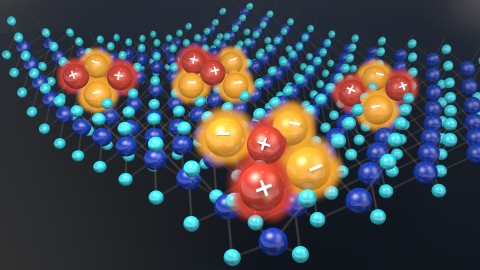Submitted by Dr F. Gomollon-Bel on Fri, 14/09/2018 - 08:04
Understanding quintons could speed up communications and bring new functionalities in quantum technologies

Charged elementary particles are responsible for the electronic properties of materials and devices. The world of optics, however, is ruled by quasiparticles known as excitons – collections of few particles that behave like a single being. A team of researchers from the Cavendish Laboratory and the Cambridge Graphene Centre at the University of Cambridge, together with collaborators in the US and Japan, discovered a new type of quasiparticle in an atomically thin layered material: a monolayer of tungsten selenide. These new particles are called ‘quintons’ , since they comprise 5 particles: three electrons and two holes. They were theoretically predicted, but never experimentally detected.
‘Quintons are the first example of charged biexcitons ever described,’ explains Matteo Barbone, Research Associate at the Cavendish Laboratory and the Cambridge Graphene Centre. ‘We also proved the existence of neutral biexcitons in layered materials, which had never been confirmed,’ adds Barbone. Neutral biexcitons have 4 particles, 2 electrons and 2 holes, with a perfect balance of charges. A quinton can be obtained by adding a charge, either positive or negative, to a neutral biexciton.
‘We demonstrated how to switch biexcitons into quintons using an electric field,’ explains Alejandro R.-P. Montblanch, PhD student at the Cavendish Laboratory. ‘Thanks to this, one could use them to create qubits, the basic unit of information in a quantum system,’ he adds.
The team did not stop at the identification of biexcitons and their charged peers – quintons. They dug into the optical signatures of these particles and discovered that neutral biexcitons could exhibit different spins, a pure quantum property of such particles. Mete Atature, professor of physics at Cambridge University explains how this ‘gives us new opportunities for realising quantum simulators.’ ‘Now, we might have a chance to introduce charge and spin into the interactions and the collective behaviour of these quasiparticles, switchable merely by a voltage bias,’ he explains.
They also carried out a complete optical study to fully understand the physical properties of excitons and quintons, and how they behave in the presence of a magnetic field. ‘We showed that biexcitons and quintons become brighter if the magnetic field moves them to higher energy,’ explains Barbone.
Layered materials also contain quantum emitters that can produce streams of single photons, and can be localized on demand, and electrically controlled, as demonstrated in previous works by Cambridge. Entangled particles interact with each other even when separated by large distances. ‘If we could trap a confined version of these quintons in quantum emitters, we could study entanglement in photon-photon-electron trios, which could find applications in quantum communications,’ adds Barbone.
Andrea C. Ferrari, professor of Nanotechnology at Cambridge University and Director of the Cambridge Graphene Centre, adds: ‘The experimental proof of the existence and stability of such large quasi-particles confirms again how layered materials are a constant source of new physics. The next goal is to control and confine these quintons, with the dream of using them in new quantum technology devices.’
'Charge-tuneable biexciton complexes in monolayer WSe2.' Matteo Barbone, Alejandro R.-P. Montblanch, Dhiren M. Kara, Carmen Palacios-Berraquero, Alisson R. Cadore, Domenico De Fazio, Benjamin Pingault, Elaheh Mostaani, Han Li, Bin Chen, Kenji Watanabe, Takashi Taniguchi, Sefaattin Tongay, Gang Wang, Andrea C. Ferrari & Mete Atatüre. Nature Communications, 2018, 9, 3721, DOI: 10.1038/s41467-018-05632-4.

